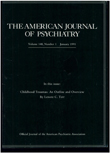A neuroanatomical hypothesis for panic disorder
Abstract
Anxiety disorders, the most common psychiatric conditions in the United States, have generated a great deal of research and scientific debate. Panic disorder, the best-studied anxiety disorder, is often believed to be either a biological disease or a psychological disease. The authors present a neuroanatomical model of panic disorder that attempts to reconcile these views. The model locates the three components of the disease--the acute panic attack, anticipatory anxiety, and phobic avoidance--in three specific sites of the CNS: the brainstem, limbic system, and prefrontal cortex, respectively. The authors suggest experiments to test their model.
Access content
To read the fulltext, please use one of the options below to sign in or purchase access.- Personal login
- Institutional Login
- Sign in via OpenAthens
- Register for access
-
Please login/register if you wish to pair your device and check access availability.
Not a subscriber?
PsychiatryOnline subscription options offer access to the DSM-5 library, books, journals, CME, and patient resources. This all-in-one virtual library provides psychiatrists and mental health professionals with key resources for diagnosis, treatment, research, and professional development.
Need more help? PsychiatryOnline Customer Service may be reached by emailing [email protected] or by calling 800-368-5777 (in the U.S.) or 703-907-7322 (outside the U.S.).



